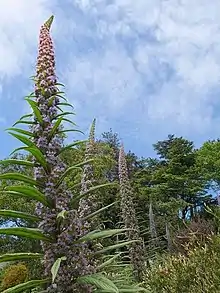Echium pininana
Echium pininana, the tree echium, pine echium or giant viper's-bugloss, is a species of flowering plant in the borage family Boraginaceae. It is endemic to the Canary Islands, where it is restricted to the island of La Palma.[2] It is cultivated in gardens of Britain and Ireland, and it has naturalized along the northern California coast in San Mateo and Mendocino Counties. Its native habitat is laurel forests, where it is now endangered through habitat loss.
| Echium pininana | |
|---|---|
 | |
| Scientific classification | |
| Kingdom: | Plantae |
| Clade: | Tracheophytes |
| Clade: | Angiosperms |
| Clade: | Eudicots |
| Clade: | Asterids |
| Order: | Boraginales |
| Family: | Boraginaceae |
| Genus: | Echium |
| Species: | E. pininana |
| Binomial name | |
| Echium pininana Webb & Berthel., 1847 | |
The Latin specific epithet pininana means "small pine",[3] though E. pininana is neither closely related to the pine, nor does it resemble that plant.
It is a biennial or triennial, showing little more than a leaf in the first year, but subsequently producing a flower spike up to 4 metres (13 ft) high with a dense mass of leaves and small blue flowers.
The plant is recommended for the southern maritime counties of England, the Channel Islands and the Scilly Isles. There are, however, reports of successful cultivation in the English Midlands and Yorkshire, albeit in favourable locations. Specimens are also grown in Dublin gardens at Howth and in the Irish National Botanic Gardens at Glasnevin. The plant also grows readily in North Wales where it seeds very widely. Although E. pininana is half-hardy in Britain and Ireland, it will self-seed to form clusters of plants, and it is suggested that by natural selection a hardier variety will emerge.[4] The plant is most vulnerable to frosts in its first year. Because of its large leaves when partly grown, it is also very susceptible to wind damage. Hence a sheltered garden position is essential.
This plant has gained the Royal Horticultural Society's Award of Garden Merit.[5][6]
References
- Santos Guerra, A. & Reyes Betancort, J.A. (2011). "Echium pininana". The IUCN Red List of Threatened Species. IUCN. 2011: e.T165250A5996251. doi:10.2305/IUCN.UK.2011-1.RLTS.T165250A5996251.en. Retrieved 22 May 2018.
- Manuel Arechavaleta, S. Rodríguez, Nieves Zurita, A. García (Hrsg.): Lista de especies silvestres de Canarias. Hongos, plantas y animales terrestres (List of Forest Species of the Canary Islands). 2009. Gobierno de Canarias, p. 151 ISBN 978-84-89729-21-6
- Harrison, Lorraine (2012). RHS Latin for Gardeners. United Kingdom: Mitchell Beazley. ISBN 184533731X.
- "Increase Of Cold Hardiness Of Echium Pininana Through Natural Selection". December 1992. Archived from the original on 27 June 2009. Retrieved 22 May 2018.
- "RHS Plantfinder - Echium pininata". Retrieved 12 January 2018.
- "AGM Plants - Ornamental" (PDF). Royal Horticultural Society. July 2017. p. 35. Retrieved 24 January 2018.
